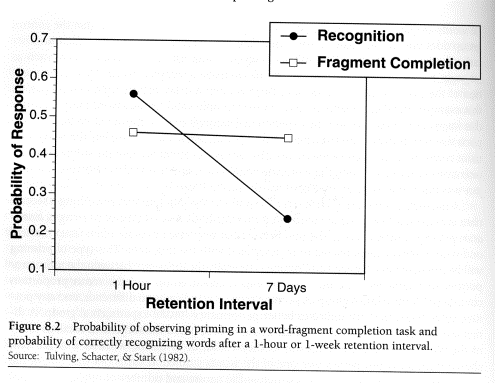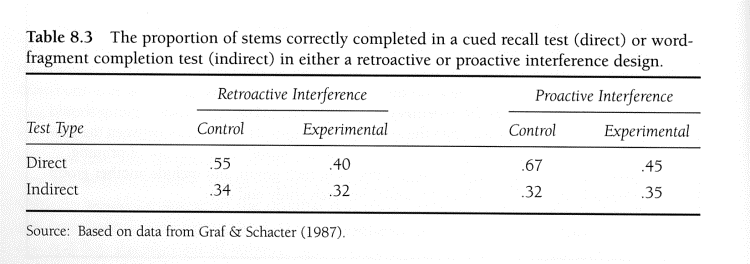
Psy
342 Learning & Memory
Implicit (Nonconscious) Memory
Chapter
11
I. Implicit
Memory
A.
Definitions
Learning
instructions—incidental or intentional
Type
of test—implicit or indirect vs. explicit or direct
Memory
used by S— implicit (nonconscious) or explicit (conscious)
Implicit
Learning—acquiring knowledge about stimuli without a conscious attempt.
B.
Explicit vs. implicit measures
Explicit
(direct) memory test—Ss are instructed to remember information
Examples—recall,
recognition
Implicit
(indirect) memory test—Ss perform a cognitive task which is facilitated by previous
experience with the material.
Examples—word-stem completion, word-fragment completion, repetition priming
II.
Evidence for Implicit Memory
A.
Amnesia patients
Warrington
and Weiskrantz (1968) --generally show intact procedural memory but lack of
declarative memory. Tower
of Hanoi Example
B.
Research with Normal Adults
Kihlstsrom
et al. (1990)
C.
Dissociation—when a variable affects one test differently than another test
(variable x test interaction)
Tulving,
Schacter, and Stark (1982)
Phase
I—learn a list of 96 words.
Phase
II (1 hr. later)—word-fragment completion test or a recognition test.
Phase
III (7 days later)—tests were given for the other 48 study words.

For
recognition test, performance declined over the retention interval.
For
the word completion test, performance remained the same across retention
intervals
Dissociation
exists
Graf
& Schacter (1987)—RI and PI affected direct tests of memory but did not
affect indirect tests.
Phase
I—Ss studied word pairs
Phase
II—Same processing to a second list of word pairs.
Phase
III—Testing. Cued recall (direct) and word-fragment completion
(indirect).

For
RI—control Ss performed more accurately than experimental Ss on the direct
test. On the indirect test, control and experimental performed at same levels,
indicating no interference.
For
PI—control Ss performed better than experimental Ss on direct test. On
indirect test, performance was equivalent.
This
represents a dissociation.
III. Multiple
Memory Systems
Dissociations between
direct and indirect tests arise because the tests tap different underlying
memory systems.
What
is a memory system?
Class inclusion operations
Properties and Relations
Convergent dissociations

Schacter and Tulving
(1994)—suggest five memory systems and nearly a dozen subsystems.
Procedural vs.
declarative memory
Episodic
(autobiographical) and semantic (generic) memory
IV.
Two Processes--recollection and
familiarity